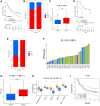Pyroptosis patterns of colon cancer could aid to estimate prognosis, microenvironment and immunotherapy: evidence from multi-omics analysis
- PMID: 36152052
- PMCID: PMC9550258
- DOI: 10.18632/aging.204302
Pyroptosis patterns of colon cancer could aid to estimate prognosis, microenvironment and immunotherapy: evidence from multi-omics analysis
Abstract
Pyroptosis plays a critical role in the occurrence and development of colon cancer (CC). However, the specific mechanisms of pyroptosis patterns on immune regulation and tumor microenvironment (TME) formation in CC remain unclear. Based on 30 pyroptosis-related genes (PRGs), we evaluated the pyroptosis patterns of 1689 CC samples from the Cancer Genome Atlas and the Gene Expression Omnibus databases. The signatures of pyroptosis patterns and PRGs were identified in CC. In addition to systematically associating these patterns with TME cell infiltration characteristics, we constructed a pyroptosis signature score (PPSscore) to quantify pyroptosis patterns in individual tumor patients with immune responses. We discovered three distinct pyroptosis patterns, each with a different survival probability and being biologically relevant. TME infiltrating characteristics of revealed these patterns, consistent with immune-inflamed, immune-desert and immune-excluded phenotypes. Furthermore, a low PPSscore was associated with better clinical benefits. A high PPSscore was associated with a lower chance of survival due to its association with stromal activation. Additionally, two immunotherapy cohorts revealed that patients with lower PPSscore had better immune responses and durable clinical benefits. Our findings indicate that pyroptosis patterns play a vital role in immunoregulation and the formation of TME in CC.
Keywords: The Cancer Genome Atlas; colon cancer; immunotherapy; pyroptosis patterns; tumor microenvironment.
Conflict of interest statement
Figures






Similar articles
-
Molecular subtypes identified by pyroptosis-related genes are associated with tumor microenvironment cell infiltration in colon cancer.Aging (Albany NY). 2022 Nov 16;14(22):9020-9036. doi: 10.18632/aging.204379. Epub 2022 Nov 16. Aging (Albany NY). 2022. PMID: 36384889 Free PMC article.
-
Correlations between the modification patterns mediated by pyroptosis-related genes, tumor microenvironment, and immunotherapy in soft tissue sarcoma.Medicine (Baltimore). 2024 May 17;103(20):e38173. doi: 10.1097/MD.0000000000038173. Medicine (Baltimore). 2024. PMID: 38758862 Free PMC article.
-
Pyroptosis Patterns Characterized by Distinct Tumor Microenvironment Infiltration Landscapes in Gastric Cancer.Genes (Basel). 2021 Sep 28;12(10):1535. doi: 10.3390/genes12101535. Genes (Basel). 2021. PMID: 34680930 Free PMC article.
-
Ferroptosis, necroptosis, and pyroptosis in the tumor microenvironment: Perspectives for immunotherapy of SCLC.Semin Cancer Biol. 2022 Nov;86(Pt 3):273-285. doi: 10.1016/j.semcancer.2022.03.009. Epub 2022 Mar 12. Semin Cancer Biol. 2022. PMID: 35288298 Review.
-
Crosstalk of pyroptosis and cytokine in the tumor microenvironment: from mechanisms to clinical implication.Mol Cancer. 2024 Nov 30;23(1):268. doi: 10.1186/s12943-024-02183-9. Mol Cancer. 2024. PMID: 39614288 Free PMC article. Review.
Cited by
-
Research progress on the effect of pyroptosis on the occurrence, development, invasion and metastasis of colorectal cancer.World J Gastrointest Oncol. 2024 Aug 15;16(8):3410-3427. doi: 10.4251/wjgo.v16.i8.3410. World J Gastrointest Oncol. 2024. PMID: 39171180 Free PMC article. Review.
-
FN1, a reliable prognostic biomarker for thyroid cancer, is associated with tumor immunity and an unfavorable prognosis.Oncol Lett. 2024 Aug 26;28(5):510. doi: 10.3892/ol.2024.14643. eCollection 2024 Nov. Oncol Lett. 2024. PMID: 39268167 Free PMC article.
-
A Pyroptosis-Related Gene Signature Predicts Prognosis and Tumor Immune Microenvironment in Colorectal Cancer.Technol Cancer Res Treat. 2024 Jan-Dec;23:15330338241277584. doi: 10.1177/15330338241277584. Technol Cancer Res Treat. 2024. PMID: 39155627 Free PMC article.
-
From Inflammasomes to Pyroptosis: Molecular Mechanisms in Chronic Intestinal Diseases - Opportunity or Challenge?J Inflamm Res. 2025 Mar 7;18:3349-3360. doi: 10.2147/JIR.S498703. eCollection 2025. J Inflamm Res. 2025. PMID: 40070928 Free PMC article. Review.
References
Publication types
MeSH terms
Substances
LinkOut - more resources
Full Text Sources

